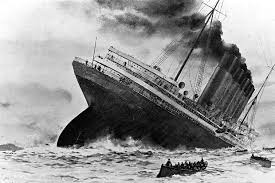 Introduction
Introduction
If we look back at history (2008 in particular), the market collapse that occurred is attributed by many observers to have been the result of a liquidity crises. With the fall of Lehman Brothers, the crunch was upon us as billions of dollars of underlying instruments began to be liquidated (credit default swaps in particular engineered by AIG Financial Products and others). Financial engineering (basically high-end computer modelling would make us all millionaires) was at its peak until it fell off the cliff. And when you look at history, it was just another get rich quick scheme that failed.
Systemic Risks of Exchange Traded Funds
Well, here we go again. It seems that within the wonderful world of exchange traded funds (ETFs) the brave, soldiering on financial engineers have yet again found a home. Without very much fanfare and notoriety the people who brought you Lehman Brothers and AIG Financial Products are back in action with the new darling of potential financial collapse. In a paper written for the Bank for International Settlements entitled: BIS Working Papers No 343 Market structures and systemic risks of exchange-traded funds the author looks at the risks now embedded in ETFs. Similarly the Financial Times of London reported in an article entitled Record growth for exchange traded funds despite regulatory fears that there are growing concerns about the potential adverse consequences of ETF structures on markets.
The problem is that many ETFs now include complex structures used to replicate the movement of certain indices by using derivatives rather than the underlying instrument. As we learned , the use of derivatives allows for the introduction of financial leverage given that swap counterparties do not require the positions with them are secured by other assets or supported 100 per cent by equity (cash). These structures are in many respects similar to those that brought the house down in 2008. The financial system is at risk in pretty much the same way that it was them. You get a “domino effect” if one of the players stumbles or tumbles.
Definition of ‘Leveraged ETF’
An exchange-traded fund (ETF) that uses financial derivatives and debt to amplify the returns of an underlying index. Leveraged ETFs are available for most indexes, such as the Nasdaq-100 and the Dow Jones Industrial Average. These funds aim to keep a constant amount of leverage during the investment time frame, such as a 2:1 or 3:1 ratio.
Here is an example of a leveraged ETF – Direxion Daily Small Cap Bull and Bear 3x Shares.
Here is a brief overview of the ETF provided by the manager’s:
Overview
The Direxion Daily Small Cap Bull and Bear 3x Shares seek the daily investment results, before fees and expenses, of 300% or 300% of the inverse (or opposite) of the performance of the Russell 2000® Index. There is no guarantee the funds will meet their stated investment objectives.
These leveraged ETFs seek a return that is +300% or -300% of the return of their benchmark index for a single day. The funds should not be expected to provide three times or negative three times the return of the benchmark’s cumulative return for periods greater than a day.
If you have a look at the financial statements of the ETF you’ll notice that the leverage in the fund is provided through equity swaps. There is no debt on the balance sheet that I can see. There is a very lengthy note to the financial statements describing the swap arrangements that are entered into and calculating the mark to market gain or loss on the outstanding contracts.
It would seem to me that there are a great number of these equity derivative contracts out there. The question is what types of events which cause these contracts to unwind. Presumably the exposures created are not that dissimilar from the credit derivatives disaster that plagued us in 2008.
These swaps are entered into with the usual suspects-Bank or America, Citibank, Deutsche Bank and Banque Paribas. These are counterparties that have been involved in swap markets from the early days in the 1980s. They continue to take on these risks because the contracts are capital friendly and hence generate significant returns on the bank’s capital.
Another question that pops up in my mind is where are the regulators in all this? This is another prime example of banks entering into transactions that would have significant material adverse implications for financial markets if there was a major disruption of some sort-some kind of liquidity event that triggers something larger. Here the banks, again, are being allowed to get into something that may endanger the financial system. In 2008 the market activity was outside the parameters of the stress testing of assets that occurred at the major financial institutions and that regulators relied upon so heavily. When something happens that causes a major market disruption involving ETFs it will probably be outside the “worst case scenario.” It always is. If the regulatory “stress testing” included an outlying event, they would have put the “clamps” on by now. The reality is that the train has already left the station. It would be difficult to unwind what is already out there without major market disruption. So the regulators, in my opinion, remain silent.

Conclusion
I am reminded in some ways of the Great Crash of 1929. During the time preceding the crash, the financial engineers of that time created the investment trusts. The investment trusts used leverage to enhance the returns on their portfolios at a time when it seemed that the stock market would go up forever. Well the leverage worked in their favor when markets were going up and accelerated the market decline when the market was going down.
We’ve been here before and will get their again. You can bet on it. 2008 is just a faint memory in the under thirty crowd cranking those algorithms through their computers. The B school graduates and the PhDs in mathematics are at it again (or rather still). The old timers are gone, the regulators co-opted by the fact that the balances are so large, there is no going back. The clock is ticking.
In the end, I believe that if I invest in sound business, they will withstand the test of time and market corrections.

Here is a brief video discussing what systemic risk is.
Some Additional Information
I have just completed reading a paper delivered by the Securities & Exchange Commission Commissioner Michael S. Piwowar entitled: Remarks at the 2015 Mutual Funds and Investment Management Conference. In that presentation Commissioner Piwowar attacks a number of regulatory bodies regarding their views on the possible impact that leveraged ETFs may have on financial markets:
Another example of jumping to a conclusion without engaging in a deliberate analysis of available data is with respect to leveraged inverse ETFs. Leveraged ETFs typically are designed to achieve their stated performance objectives on a daily basis. To accomplish their objectives, leveraged ETFs pursue a range of investment strategies through the use of swaps, futures contracts, and other derivative instruments. Over the past several years, regulators, sponsors, and brokers have engaged in efforts to convey to investors the understanding that performance of leveraged ETFs over longer periods of time can significantly differ from the underlying index or benchmark.
But, there is a false narrative about leveraged ETFs being spread by the prudential regulators. It is the unsubstantiated assertion that these products contribute to increased volatility in the financial markets because they must rebalance their portfolios in the same direction as the contemporaneous return on the underlying assets in order to maintain a constant leverage ratio. In other words, these types of ETFs purchase assets when they go up and sell assets when they go down. According to the prudential regulators, the added volatility can therefore be destabilizing to the markets, especially during periods of adverse stress.
A recent working paper, however, by researchers at the Federal Reserve and the Pennsylvania State University looked at actual data and the operations of leveraged ETFs.[29] Their paper examined the effects of capital flows on leveraged ETFs and found that earlier criticisms about the contribution of such ETFs to market volatility are likely exaggerated. The paper observed, empirically, that capital flows substantially reduce the need for leveraged ETFs to rebalance when returns are large in magnitude. The capital flows thereby mitigate the potential for leveraged ETFs to amplify volatility. In other words, one of the Fed’s own economists concludes that concerns about leveraged ETFs are overblown.
Notwithstanding the prudential regulators’ baseless criticisms (these are pretty strong terms being used by one regulator talking about another), there are three areas of our regulatory regime that might warrant a closer look: fund data reporting, in-kind redemptions, and temporary suspension of redemptions.
The Commissioner is referring to a paper that I have linked above entitled: Are Concerns About Leveraged ETFs Overblown?. If you can read this paper than you are way up the curve from me.
Here is their conclusion:
Concluding Remarks
Leveraged and inverse ETFs have received heavy criticism based on the belief that they exacerbate volatility in financial markets. We show that concerns about these types of products are likely exaggerated. Empirically, we find that capital flows considerably reduce ETF rebalancing demand and, therefore, mitigate the potential for ETFs to amplify volatility. Our analysis has relevant and timely policy implications, as regulators are reportedly considering changes to how ETFs are regulated.
With all due respect to Commissioner Piwowar, he is an academic and has no market experience. Arming himself with academic studies as the basis on which to protect the stability of the global financial system is reminiscent of what happened during the crisis of 2008. Suffice it to say that this kind of blind optimism expressed by the Commissioner is the type of optimism that got us into the 2008 financial crisis.
Perhaps Commissioner Piwowar should have a look at this academic paper presented by four professors at New York University entitled: Market Failures and Regulatory Failures: Lessons from Past and Present Financial Crises.
Abstract
“The paper analyzes the financial crisis of through the lens of market failures and regulatory failures. We present a case that there were four primary failures contributing to the crisis: excessive risk-taking in the financial sector due to mispriced government guarantees; regulatory focus on individual institution risk rather than systemic risk; opacity of positions in financial derivatives that produced externalities from individual firm failures; and runs on the unregulated banking sector that eventually threatened to bring down the entire financial sector. In emphasizing the role of regulatory failures, we provide a description of regulatory evolution in response to the panic of 1907 and the Great Depression, why the regulation put in place then was successful in addressing market failures, but how, over time, especially around the resolutions of Continental Illinois, Savings and Loans crisis and Long-Term Capital Management, expectations of too-big-to-fail status got anchored. We propose specific reforms to address the four market and regulatory failures we identify, and we conclude with some lessons for emerging markets.”
It’s really hard to believe that here we are in 2016 having suffered through the Great Recession of 2008 and comments like this continue to be made by regulators. Academic studies in the past have not protected us from market calamities nor will they save us from similar events in the future. We can fight it out with study after study, but I believe that we should never underestimate the ability of market participants who have no “skin in the game” to tank the global financial system.

Another recent paper by the Cato Institute looks at Math Gone Mad: Regulatory Risk Modeling by the Federal Reserve. It was written by Kevin Dowd City University London – Sir John Cass Business School.
The paper looks at the the threat of faulty financial modeling and its contribution to recent financial crisis. One of the paper’s conclusions is:
“The Fed’s obsession with math modeling is creating a huge and growing risk for the U.S. financial system. Yet even though regulatory risk modeling was a key factor behind the weakening of the banking system that broughton the crisis, and even though regulatory stress testing has produced disaster after disaster in recent years, the Fed asks us to believe that it alone, out of all the regulatory stress testers,will be the one to get it right—and this despite the Fed’s own disastrous forecasting record,not least its total failure to anticipate the 2007—2009 financial crisis. The reality is that regulatory risk modeling doesn’t work in the long run. It didn’t work with Fannie and Freddie, it didn’t work in Iceland, it didn’t work in Ireland, it didn’t work in Cyprus, and it didn’t work across much of the rest of Europe, either. There is no reason to think that the Fed’s risk model will be any exception. A betting man would therefore describe the odds of the Federal Reserve leading the banking system into another disaster as a racing certainty. When the postmortem is over, the main damage will turn out to have been done by some risk that the Fed’s stress tests completely missed or, at best, greatly underestimated.

That’s the way these things always are. But what clinches it for me is the fact that the Fed is so supremely confident that its stress tests will protect the banking system.
The best insights into the future come not from math modeling but from ancient Greek literature, which reiterates again and again the fates of those who were foolish enough to defy the gods. A case in point is an experienced sea captain who once said:
When anyone asks me how I can best describe my experiences in nearly 40 years at sea I merely say uneventful. Of course, there have been Winter gales and storms and fog and the like, but in all my experience I have never been in any accident of any sort worth speaking about. I have seen but one vessel in distress. . . I never saw a wreck and have never been wrecked, nor was I ever in any predicament that threatened to end in disaster of any sort. . . . I will go a bit further. I will say that I cannot imagine any condition which could cause a ship to founder. I cannot conceive of any vital disaster happening to this vessel. Modern shipbuilding has gone beyond that.

These were the immortal words of E. J. Smith, the captain of the Titanic. However, one has to admit that the Titanic comparison is perhaps a little unfair—at least to Captain Smith. After all, he hadn’t ever encountered a crisis, and he did have good reason to be confident in his ship, whereas we have every good reason to believe that the Fed’s risk regulatory modeling agenda will end up underwater. So when the Federal Reserve Titanic eventually hits its iceberg, we can only hope that its captain will take a leaf out of Captain Smith’s book and have the decency to go down with her ship.”
The important point raised here is that what usually creates financial system chaos is some unforeseen risk, which is what happened in 2008 when all the stress testing and modeling was overwhelmed by a series of events not contemplated. Does this fact not show up on Commissioner’s Piwowar radar screen?
If Commissioner Piwowar ever worked on a trading floor he would see that traders have an incentive compensation package that might best be characterized by heads I win tails you lose. If I perform I have the potential of a huge bonus. If I earn that bonus and tank the place the next year, I don’t pay the money back. Talk about a moral hazard!
So it might make sense if regulators around the world would roll up their sleeves and spend one week on a trading floor as a junior. It would both be a humbling and an informative experience for all concerned.
You must be logged in to post a comment.